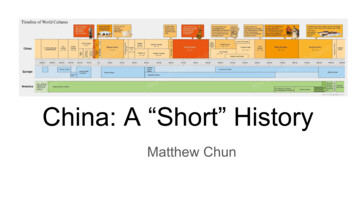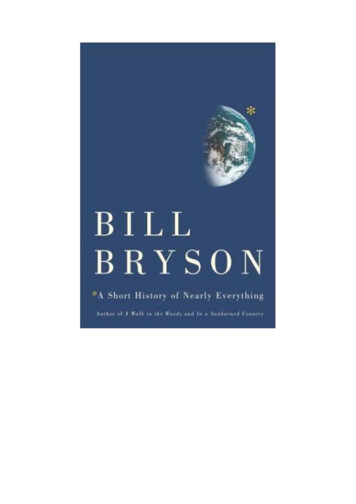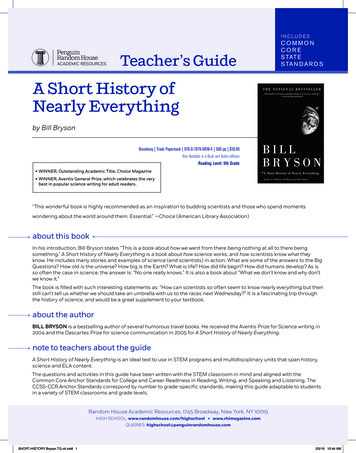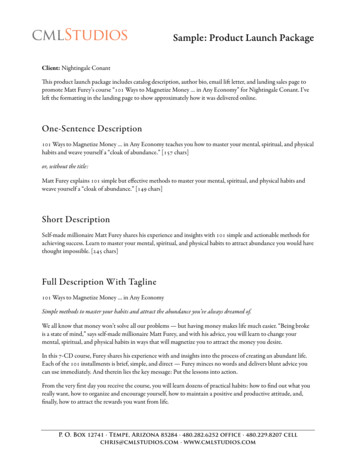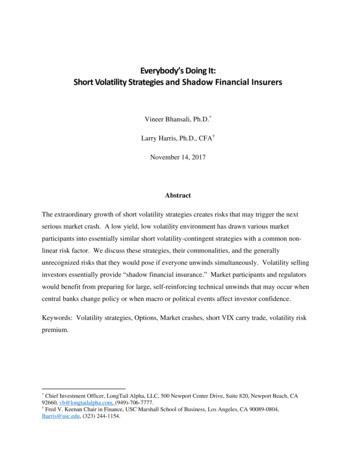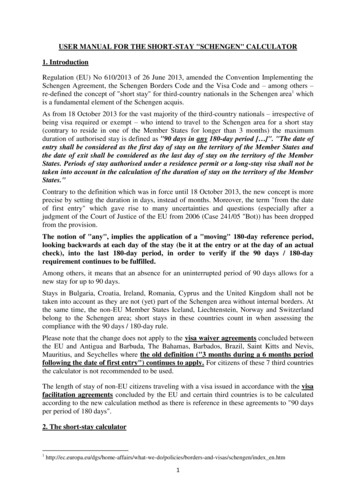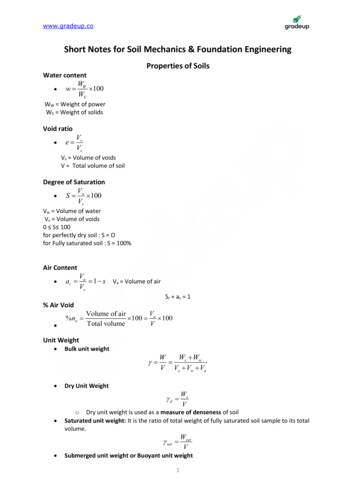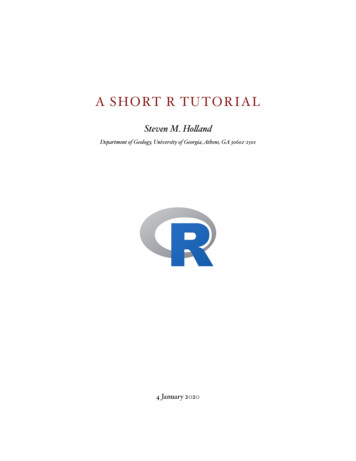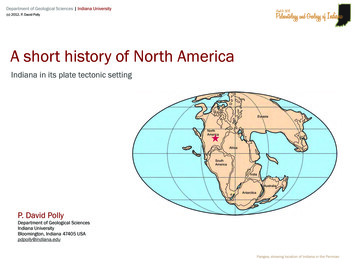
Transcription
Department of Geological Sciences Indiana University(c) 2012, P. David PollyGeol G-308Paleontology and Geology of IndianaA short history of North AmericaIndiana in its plate tectonic settingP. David PollyDepartment of Geological SciencesIndiana UniversityBloomington, Indiana 47405 USApdpolly@indiana.eduPangea, showing location of Indiana in the Permian
Department of Geological Sciences Indiana University(c) 2012, P. David PollyGeol G-308Paleontology and Geology of IndianaObjectives1. Introduction to Geological Time Scale2. Structure of the Earth, formation of rocks and continents3. Early history of the Earth4. Continental history of the Phanerozoic5. Oxygen, carbon dioxide, and sea level through the Phanerozoic
Department of Geological Sciences Indiana UniversityGeol G-308Paleontology and Geology of Indiana(c) 2012, P. David PollyEraPeriodBasic geological time scaleCenozoicQuaternaryQuiz next Friday (25 January)NeogeneMnemonic for Paleozoic leistoceneTriassicPaleozoicOysters(millions of years 4164444885422.5 billion4.6 billion
Department of Geological Sciences Indiana University(c) 2012, P. David PollyGeol G-308Paleontology and Geology of IndianaStructure of the EarthLithosphere, or crustThe outer layer of the earth that ‘floats’ onits surfaceOceanic crustHeavy, basaltic crust that forms the oceanfloors and originates at spreading ridgesContinental crustLighter, more varied crust that has formedfrom tectonism and erosionAsthenosphereA ‘plastic’ layer that is easily deformed bythe massive movements in the mantleStanley, Earth System Processes
Department of Geological Sciences Indiana UniversityGeol G-308Paleontology and Geology of Indiana(c) 2012, P. David PollyMajor types of crustal rockIndiana’s surface rocks are exclusively felsicContinental crust: felsichigh concentration of silica andaluminum as quartz and feldspar.Average density is 2.7 g/cm3Oceanic crust: maficHigh concentration of iron (Fe) andmagnesium in basalt rocks. Averagedensity is 3.0 g/cm3
Department of Geological Sciences Indiana UniversityGeol G-308Paleontology and Geology of Indiana(c) 2012, P. David PollyCrustal rock floatsand felsic continental crust floats higher than mafic oceanic crustLight crust floats higher, heavy crust sinks lowerthis is an important observation about basins filling with sediments:they sink as they fill, thus allowing more sediments to enter the basinIsostasy equilibrium point of continental “floating”Felsic(lighter, thicker)Mafic(heavier, thinner)
Department of Geological Sciences Indiana UniversityGeol G-308Paleontology and Geology of Indiana(c) 2012, P. David PollyConvection, creation of crust, and plate movementsHeavier ocean crust (mafic) is created by upwelling at mid-ocean rides and low andheavy, slipping under lighter crust when plates come together.Continental crust (felsic) is created when ocean crust is subducted and melts.Lighter elements bubble up and float high (orogeny).Mafic(heavier, thinner)Felsic(lighter, thicker)
Department of Geological Sciences Indiana University(c) 2012, P. David PollyEarly history of the EarthGA gigannum, or billions of years agoMA megannum, or mllions of years agoHadean, 4.6 - 3.8 Ga Oldest rocks 4.2 Ga (zircon grains in ancientsandstones) Origin of life circa 4.0 GaArchaean, 3.8-2.5 Ga Oldest intact crust from Acasta Gneiss and NuvvuagittuqGreenstone Belt Canada and Greenland 4.4 - 3.8 Ga Earliest fossils of photosynthetic bacteria 3.5 Ga Oxygen in atmosphere at low levels 2.5 GaProterozoic, 2.5 Ga - 545 Ma Sediments continue to cover and enlarge continents Eucaryote life 2.1 Ga Multicellular life (metazoans) 1.8 Ga First “ice age”, or glacial period, “Snowball Earth” 650Ma Vendian life (complex, soft-bodied animals) 650 - 542MaGeol G-308Paleontology and Geology of Indiana
Department of Geological Sciences Indiana University(c) 2012, P. David PollyGeol G-308Paleontology and Geology of IndianaAnatomy of a continentCraton oldest, most stable part of continent, mostly rock formed bycooling of early molten crust (also called “shield”)Mountain belts formed by later “orogenies” due to plate movementsSediments formed by weathering, erosion, transport, and depositionIgneous rocks: crystalize from molten material (sea floor spreading centers, orogeniccenters)Sedimentary rocks: originate by weathering and erosion from other rocks (Indiana’ssurface rocks are sedimentary)Metamorphic rocks: transformed and recrystalized igneous and sedimentary rocks
Department of Geological Sciences Indiana University(c) 2012, P. David PollyGeol G-308Paleontology and Geology of IndianaSurface bedrock of North AmericaUSGS, Tapestry of Time and Terrain
Department of Geological Sciences Indiana University(c) 2012, P. David PollyGeol G-308Paleontology and Geology of IndianaSkeleton outline of NA’s history1. Archean: Craton forms as “microcontinents” cooled from molten crust2. Archean: Microcontinents collide to form larger craton (Laurentia)3. Proterozoic: Laurentia grows as mountains of early craton erode and aretransported to margins4. Early Paleozoic: Laurentia begins to collide with other continents,especially along what is today eastern margin (Taconic Orogeny,Ordovician; Acadian Orogeny, Silurian-Devonian)5. Late Paleozoic: Continents come together into Pangea (AlleghenianOrogeny, Pennsylvanian)6. Mesozoic: Pangea splits apart into modern continents7. Cenozoic: Mountains and basins of western North America and CentralAmerica formed as NA moves westward and northward
Department of Geological Sciences Indiana University(c) 2012, P. David PollyGeol G-308Paleontology and Geology of IndianaProterozoic ( 524 Ma)Craton eroding flat and growingwider by depositing sedimentsaround marginsStanley, Earth System Processes
Department of Geological Sciences Indiana University(c) 2012, P. David PollyGeol G-308Paleontology and Geology of IndianaEarly Paleozoic (542- 359 Ma) Continent grows Sea level high, extensive shallow seas Taconic and Acadian orogenies formolder parts of the eastern mountains(c) Ron Blakey (http://jan.ucc.nau.edu/ rcb7/nam.html)
Department of Geological Sciences Indiana University(c) 2012, P. David PollyGeol G-308Paleontology and Geology of IndianaLate Paleozoic (359-251 Ma) Terrestrial part of grows Alleghenian Orogeny as NA, Europe, andAfrica start to collide Formation of supercontinent Pangea, inwhich all continents were connected(c) Ron Blakey (http://jan.ucc.nau.edu/ rcb7/nam.html)
Department of Geological Sciences Indiana University(c) 2012, P. David PollyGeol G-308Paleontology and Geology of IndianaMesozoic (251-65 Ma) Pangea starts to break apart Eastern mountains erode, no moreorogenies on that margin Western mountains start to form as NAis pushed to the west and north Sea levels high in Cretaceous, floodinglower parts of the continent(c) Ron Blakey (http://jan.ucc.nau.edu/ rcb7/nam.html)
Department of Geological Sciences Indiana University(c) 2012, P. David PollyGeol G-308Paleontology and Geology of IndianaCenozoic (65 - 0 Ma) Continent takes on modern form Western and Central Americanmountains continue to form Gulf coast extend from sedimentdeposition and reef building Glacial cycles in late Cenozoic(c) Ron Blakey (http://jan.ucc.nau.edu/ rcb7/nam.html)
Department of Geological Sciences Indiana University(c) 2012, P. David PollyGeol G-308Paleontology and Geology of IndianaAtmospheric oxygen levels over PhanerozoicBerner et al, 2003. Annual Review of Earth and PlanetarySciences, 31: 105-134
Department of Geological Sciences Indiana University(c) 2012, P. David PollyGeol G-308Paleontology and Geology of IndianaAtmospheric carbon dioxide levels over PhanerozoicBerner, 1990. Science, 249: 1382-1386.
Department of Geological Sciences Indiana University(c) 2012, P. David PollyGeol G-308Paleontology and Geology of IndianaSea level changes in the PhanerozoicEustasy change in sea level due to itsrise and fallMajor controls on eustasy:1. Plate movements(rise in sea floor associated with increasedmantle upwelling beneath ridges)2. Volume of continental ice caps(trap water, preventing it from returning to theoceans)Hallam, 1984. Annual Review of Earth andPlanetary Sciences, 12: 205-243.
Department of Geological Sciences Indiana University(c) 2012, P. David PollyGeol G-308Paleontology and Geology of IndianaModern topography of North AmericaNorth American topography
Department of Geological Sciences Indiana UniversityGeol G-308Paleontology and Geology of Indiana(c) 2012, P. David PollyFirst order sequences of strata in North AmericaSea LevelLowHighLowHighLowHighLowHighLowHighLow No deposition Major sedimentary unitsSloss, 1963, Sequences in the cratonic interior of NorthAmerica. GSA Bulletin, 74; 93-114.
Geol G-308 Stanley, Earth System Processes Structure of the Earth Lithosphere, or crust The outer layer of the earth that ‘floats’ on its surface Oceanic crust Heavy, basaltic crust that forms the ocean floors and originates at spreading ridges Continental crust Lighter, more varied crust that has formed from tectonism and erosion Asthenosphere A ‘plastic’ layer that is easily deformed .

